Topics
Mathematical Reasoning
- Mathematically Acceptable Statements
- New Statements from Old
- Special Words Or Phrases
- Contrapositive and Converse
- Introduction of Validating Statements
- Validation by Contradiction
- Difference Between Contradiction, Converse and Contrapositive
- Consolidating the Understanding
Sets
- Sets and Their Representations
- Empty Set (Null or Void Set)
- Finite and Infinite Sets
- Equal Sets
- Subsets
- Power Set
- Universal Set
- Venn Diagrams
- Intrdouction of Operations on Sets
- Union of Sets
- Intersection of Sets
- Difference of Sets
- Complement of a Set
- Practical Problems on Union and Intersection of Two Sets
- Proper and Improper Subset
- Open and Close Intervals
- Disjoint Sets
- Element Count Set
Sets and Functions
Relations and Functions
- Cartesian Product of Sets
- Concept of Relation
- Concept of Functions
- Some Functions and Their Graphs
- Algebra of Real Functions
- Ordered Pairs
- Equality of Ordered Pairs
- Pictorial Diagrams
- Graph of Function
- Pictorial Representation of a Function
- Exponential Function
- Logarithmic Functions
- Brief Review of Cartesian System of Rectanglar Co-ordinates
Algebra
Trigonometric Functions
- Concept of Angle
- Introduction of Trigonometric Functions
- Signs of Trigonometric Functions
- Domain and Range of Trigonometric Functions
- Trigonometric Functions of Sum and Difference of Two Angles
- Trigonometric Equations
- Trigonometric Functions
- Truth of the Identity
- Negative Function Or Trigonometric Functions of Negative Angles
- 90 Degree Plusminus X Function
- Conversion from One Measure to Another
- 180 Degree Plusminus X Function
- 2X Function
- 3X Function
- Expressing Sin (X±Y) and Cos (X±Y) in Terms of Sinx, Siny, Cosx and Cosy and Their Simple Applications
- Graphs of Trigonometric Functions
- Transformation Formulae
- Values of Trigonometric Functions at Multiples and Submultiples of an Angle
- Sine and Cosine Formulae and Their Applications
Coordinate Geometry
Complex Numbers and Quadratic Equations
- Concept of Complex Numbers
- Algebraic Operations of Complex Numbers
- The Modulus and the Conjugate of a Complex Number
- Argand Plane and Polar Representation
- Quadratic Equations
- Algebra of Complex Numbers - Equality
- Algebraic Properties of Complex Numbers
- Need for Complex Numbers
- Square Root of a Complex Number
Calculus
Mathematical Reasoning
Linear Inequalities
Principle of Mathematical Induction
Statistics and Probability
Permutations and Combinations
- Fundamental Principles of Counting
- Permutations
- Combination
- Introduction of Permutations and Combinations
- Permutation Formula to Rescue and Type of Permutation
- Smaller Set from Bigger Set
- Derivation of Formulae and Their Connections
- Simple Applications of Permutations and Combinations
- Factorial N (N!) Permutations and Combinations
Binomial Theorem
- Introduction of Binomial Theorem
- Binomial Theorem for Positive Integral Indices
- General and Middle Terms
- Proof of Binomial Therom by Pattern
- Proof of Binomial Therom by Combination
- Rth Term from End
- Simple Applications of Binomial Theorem
Sequence and Series
Straight Lines
- Slope of a Line
- Various Forms of the Equation of a Line
- General Equation of a Line
- Distance of a Point from a Line
- Brief Recall of Two Dimensional Geometry from Earlier Classes
- Shifting of Origin
- Equation of Family of Lines Passing Through the Point of Intersection of Two Lines
Conic Sections
- Sections of a Cone
- Concept of Circle
- Introduction of Parabola
- Standard Equations of Parabola
- Latus Rectum
- Introduction of Ellipse
- Relationship Between Semi-major Axis, Semi-minor Axis and the Distance of the Focus from the Centre of the Ellipse
- Special Cases of an Ellipse
- Eccentricity
- Standard Equations of an Ellipse
- Latus Rectum
- Introduction of Hyperbola
- Eccentricity
- Standard Equation of Hyperbola
- Latus Rectum
- Standard Equation of a Circle
Introduction to Three-dimensional Geometry
Limits and Derivatives
- Intuitive Idea of Derivatives
- Introduction of Limits
- Introduction to Calculus
- Algebra of Limits
- Limits of Polynomials and Rational Functions
- Limits of Trigonometric Functions
- Introduction of Derivatives
- Algebra of Derivative of Functions
- Derivative of Polynomials and Trigonometric Functions
- Derivative Introduced as Rate of Change Both as that of Distance Function and Geometrically
- Limits of Logarithmic Functions
- Limits of Exponential Functions
- Derivative of Slope of Tangent of the Curve
- Theorem for Any Positive Integer n
- Graphical Interpretation of Derivative
- Derive Derivation of x^n
Statistics
- Measures of Dispersion
- Concept of Range
- Mean Deviation
- Introduction of Variance and Standard Deviation
- Standard Deviation
- Standard Deviation of a Discrete Frequency Distribution
- Standard Deviation of a Continuous Frequency Distribution
- Shortcut Method to Find Variance and Standard Deviation
- Introduction of Analysis of Frequency Distributions
- Comparison of Two Frequency Distributions with Same Mean
- Statistics Concept
- Central Tendency - Mean
- Central Tendency - Median
- Concept of Mode
- Measures of Dispersion - Quartile Deviation
- Standard Deviation - by Short Cut Method
Probability
- Random Experiments
- Introduction of Event
- Occurrence of an Event
- Types of Events
- Algebra of Events
- Exhaustive Events
- Mutually Exclusive Events
- Axiomatic Approach to Probability
- Probability of 'Not', 'And' and 'Or' Events
- Identity function - Domain and range of this function
- Constant function - Domain and range of this function
- Polynomial function -Domain and range of this function
- Rational functions - Domain and range of this function
- The Modulus function - Domain and range of this function
- Signum function - Domain and range of this function
- Greatest integer function
Notes
(i) Identity function- In this type of functions the value of x and f(x) is identical i.e same that's why it is known as Identity function. There are two ways to represent function they are Rule and Graph.
A function is represented in Rule like, if x=1 then f(x)=1
Graph-
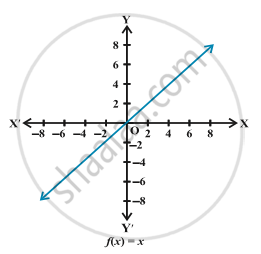
In indentical function if y=f(x) then y=x
We have already learnt that domain is a set of values of x at which function is defined. And for values of x at which function is defined, set of values of f(x) is called as Range.
Here, f(x)=x
Domain= R
Range= R
(ii) Constant function- For any value of x, f(x) is always constant. f(x)= c is the constant function.
Here, Domain= R and Range= {c}

The graph is a line parallel to x-axis. For example, if f(x)=3 for each x∈R, then its graph will be a line as shown in the Fig.
(iii) Polynomial function- A polynomial function is written as `f(x)= a_0+ a_1x+ a_2x^2+ a_3x^3+..... +a_nx^n`, where n is a non-negative integer and `a_0, a_1, a_2,...,a_n∈"R".`
There is no definite graph of a polynomial function. Say `f(x)=x^2`, draw the graph of f.

Here, `f(x)=x^2` can also be written as f: R→R
Domain= R and Range= `"R"^+`
Let's take another example, Draw the graph of the function f :R → R defined by `f (x) = x^3, x∈"R".`
f(0) = 0, f(1) = 1, f(–1) = –1, f(2) = 8, f(–2) = –8, f(3) = 27; f(–3) = –27, etc.
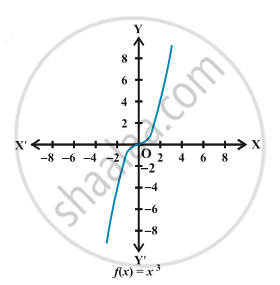
Here, `f(x)= x^3, f: "R"→"R"`
Domain= R and Range= R
(iv) Rational functions- Relation functions are of the type `f(x)= g(x)/[h(x)]≠ 0`
Example- Define the real valued function f : R – {0}→ R defined by `f(x)= 1/x, x ∈ R -{0}`
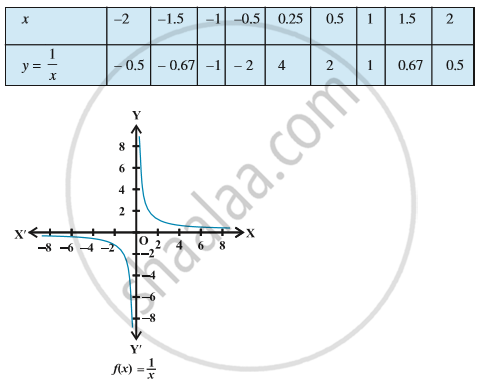
`f(x)=1/x`, Domain= R-{0} and Range= R-{0}
(v) The Modulus function- The function f: R→R defined by f(x) = |x| for each x ∈R is called modulus function. For each non-negative value of x, f(x) is equal to x. But for negative values of x, the value of f(x) is the negative of the value of x, i.e.,
\[ f(x) = \begin{cases} x, \quad x ≥ 0\\-x, \quad x< 0 \end{cases}\]
The graph of the modulus function is given in Fig.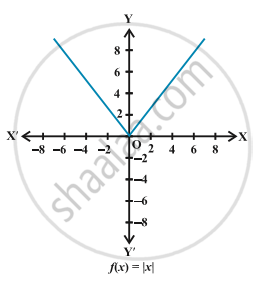
Domain= R and Range= `"R"^+`
How to break definitionof modulus function?
f(x)= |x+1|
x+1≥0
x ≥ -1
\[ f(x) = \begin{cases} (x+1) & \quad x ≥ -1\\ -(x+1) & \quad x< -1 \end{cases}\]
Here, Domain= R and Range= R^+
(vi) Signum function - The function f:R→R defined by \[ f(x) = \begin{cases}\frac {|x|}x, & \quad x ≠0\\ 0, & \quad x=0 \end{cases}\].
If we break this we get,
\[ f(x) = \begin{cases}1,\text{if } x >0\\ 0, \text{if }x=0\\-1, \text{if } x<0 \end{cases}\]
The graph of the signum function is given by the Fig
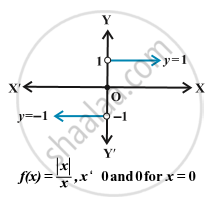
Domain= R and Range= {-1,0,1}
(vii) Greatest integer function- Greatest integer function are of type f(x)= [x]= greatest integer less than or equal to x.
Try to understand it by taking few values of x
x= (2.1), f(2.1)= [2.1]= 2
x= (3.9), f(3.9)= [3.9]= 3
x= (-2.3), f(-2.3)= [-2.3]= -3
x=5, f(5)= [5]= 5

Domain= R and Range= Integers i.e Z
